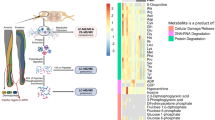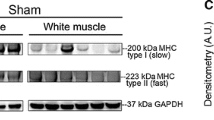Abstract
Proteome analysis was carried out to identify the proteins associated with neuropathic pain after peripheral nerve injury. Five proteins displayed different expression levels among three groups of rats. Among these proteins, creatine kinase B expression level was lower in the pain-positive rats compared to the sham or pain-negative rats. Therefore, a lower creatine kinase B expression level may be important in the development and maintenance of neuropathic pain.
Similar content being viewed by others
References
Arawaka S, Daimon M, Sasaki H, Suzuki JI, Kato T (1998) A novel autoantibody in paraneoplastic sensory-dominant neuropathy reacts with brain-type creatine kinase. Int. J. Mol. Med. 1: 597–600.
Brewer GJ, Wallimann TW (2000) Protective effect of the energy precursor creatine against toxicity of glutamate and beta-amyloid in rat hippocampal neurons. J. Neurochem. 74: 1968–1978.
Chaplan SR, Bach FW, Pogrel JW, Chung JM, Yaksh TL (1994) Quantitative assessment of tactile allodynia in the rat paw. J. Neurosci. Meth. 53: 55–63.
Dedeoglu A, Kubilus JK, Yang L, Ferrante KL, Hersch SM, Beal MF, Ferrante AR (2003) Creatine therapy provides neuroprotection after onset of clinical symptoms in Huntington's disease transgenic mice. J. Neurochem. 85: 1359–1367.
Huang J, Shibata E, Kato K, Asaeda N, Takeuchi Y (1992) Chronic exposure to n-hexane induces changes in nerve-specific marker proteins in the distal peripheral nerve of the rat. Hum. Exp. Toxicol. 11: 323–327.
Kim SH, Chung JM (1992) An experimental model for peripheral neuropathy produced by segmental spinal nerve ligation in the rat. Pain 50: 355–363.
Klivenyi P, Ferrante RJ, Matthews RT, Bogdanov MB, Klein AM, Andreassen OA, Mayer DJ, Mao J, Holt J, Price DD (1999) Cellular mechanisms of neuropathic pain, morphine tolerance, and their interactions. Proc. Natl. Acad. Sci. USA 96: 7731–7736.
Matthews RT, Yang L, Jenkins BG, Ferrante RJ, Rosen BR, Kaddurah-Daouk R, Beal MF (1998) Neuroprotective effects of creatine and cyclocreatine in animal models of Huntington's disease. J. Neurosci. 18: 156–163.
Mueller G, Wermer M, Kaddurah-Daouk R, Beal MF (1999) Neuroprotective effects of creatine in a transgenic animal model of amyotrophic lateral sclerosis. Nat. Med. 5: 347–350.
Park S, Lee M, Kim HY, Jeoung DI (2002) Proteome analysis of 5-fluorouracil-resistance-associated protein in human gastric cancer cells. Biotechnol. Lett. 24: 1141–1145.
Spruce MC, Potter J, Coppini DV (2003) The pathogenesis and management of painful diabetic neuropathy: a review. Diabet. Med. 20: 88–98.
Sullivan PG, Geiger JD, Mattson MP, Scheff SW (2000) Dietary supplement creatine protects against traumatic brain injury. Ann. Neurol. 48: 723–729.
Wallimann T, Wyss M, Brdiczka D, Nicolay K, Eppenberger HM (1992) Intracellular compartmentation, structure and function of creatine kinase isoenzymes in tissues with high and fluctuating energy demands: the phosphocreatine circuit for cellular energy homeostasis. Biochem. J. 281: 21–40.
Wendt S, Dedeoglu A, Speer O, Wallimann T, Beal MF, Andreassen OA (2002) Reduced creatine kinase activity in transgenic amyotrophic lateral sclerosis mice. Free Radic. Biol. Med. 32: 920–926.
Woolf CJ, Mannion RJ (1999) Neuropathic pain: aetiology, symptoms, mechanisms, and management. Lancet 353: 1959–1964.
Ziegler EA, Magerl W, Meyer RA, Treede RD (1999) Secondary hyperalgesia to punctate mechanical stimuli. Central sensitization to A-fibre nociceptor input. Brain 122: 2245–2257.
Zimmermann M (1983) Ethical guidelines for investigations of experimental pain in conscious animals. Pain 16: 109–110.
Author information
Authors and Affiliations
Corresponding author
Rights and permissions
About this article
Cite this article
Lee, S.C., Yoon, T.G., Yoo, YI. et al. Analysis of spinal cord proteome in the rats with mechanical allodynia after the spinal nerve injury. Biotechnology Letters 25, 2071–2078 (2003). https://doi.org/10.1023/B:BILE.0000007068.97472.89
Issue Date:
DOI: https://doi.org/10.1023/B:BILE.0000007068.97472.89




